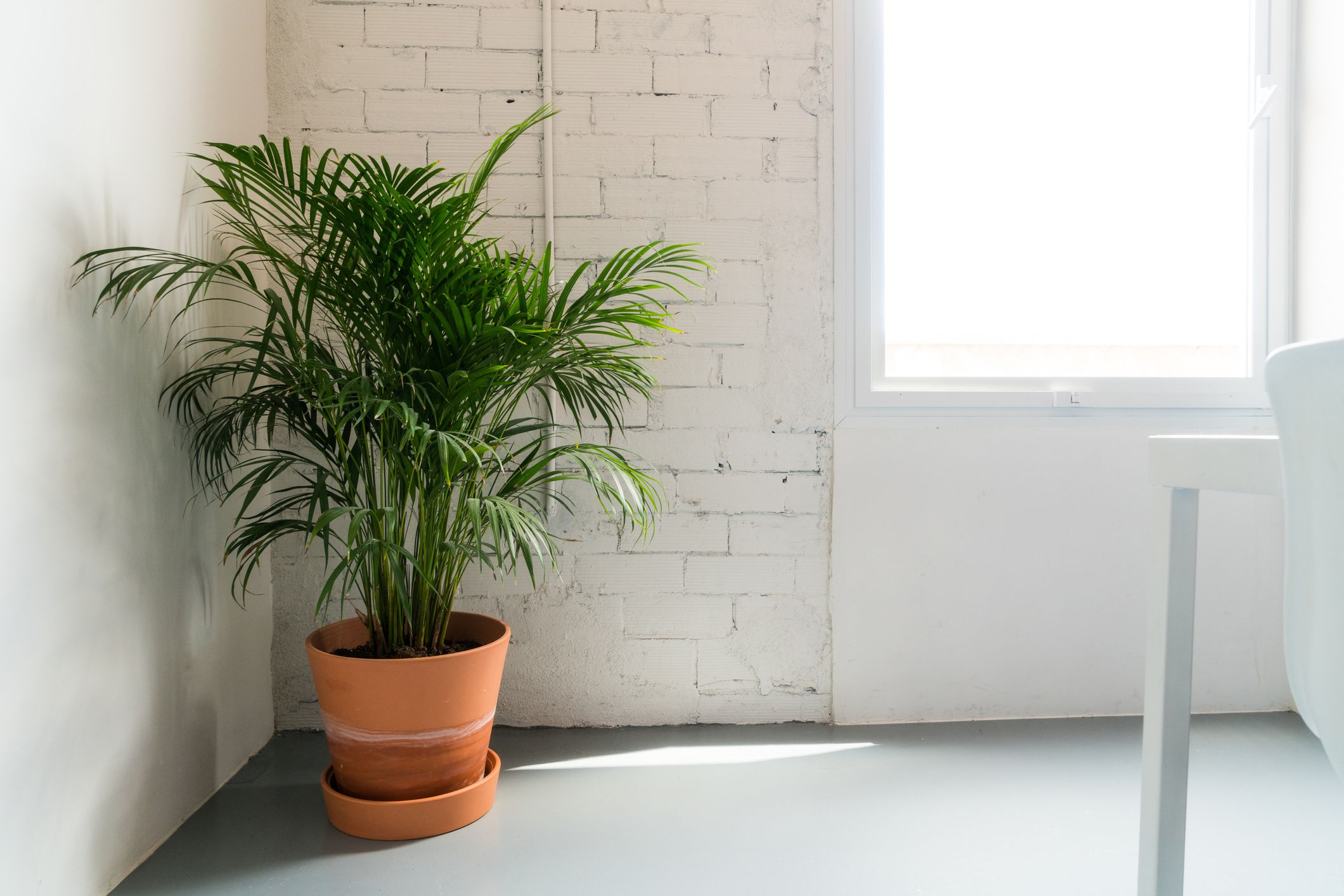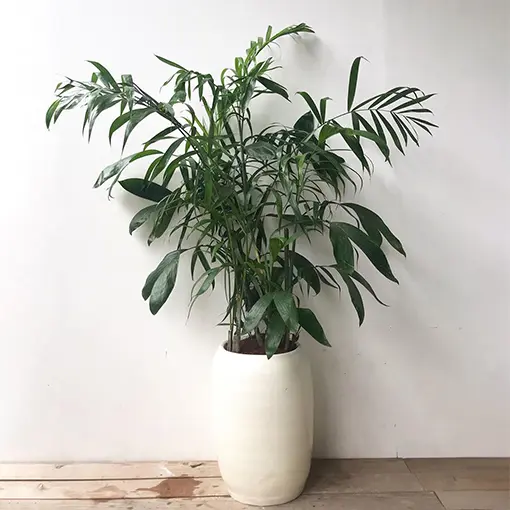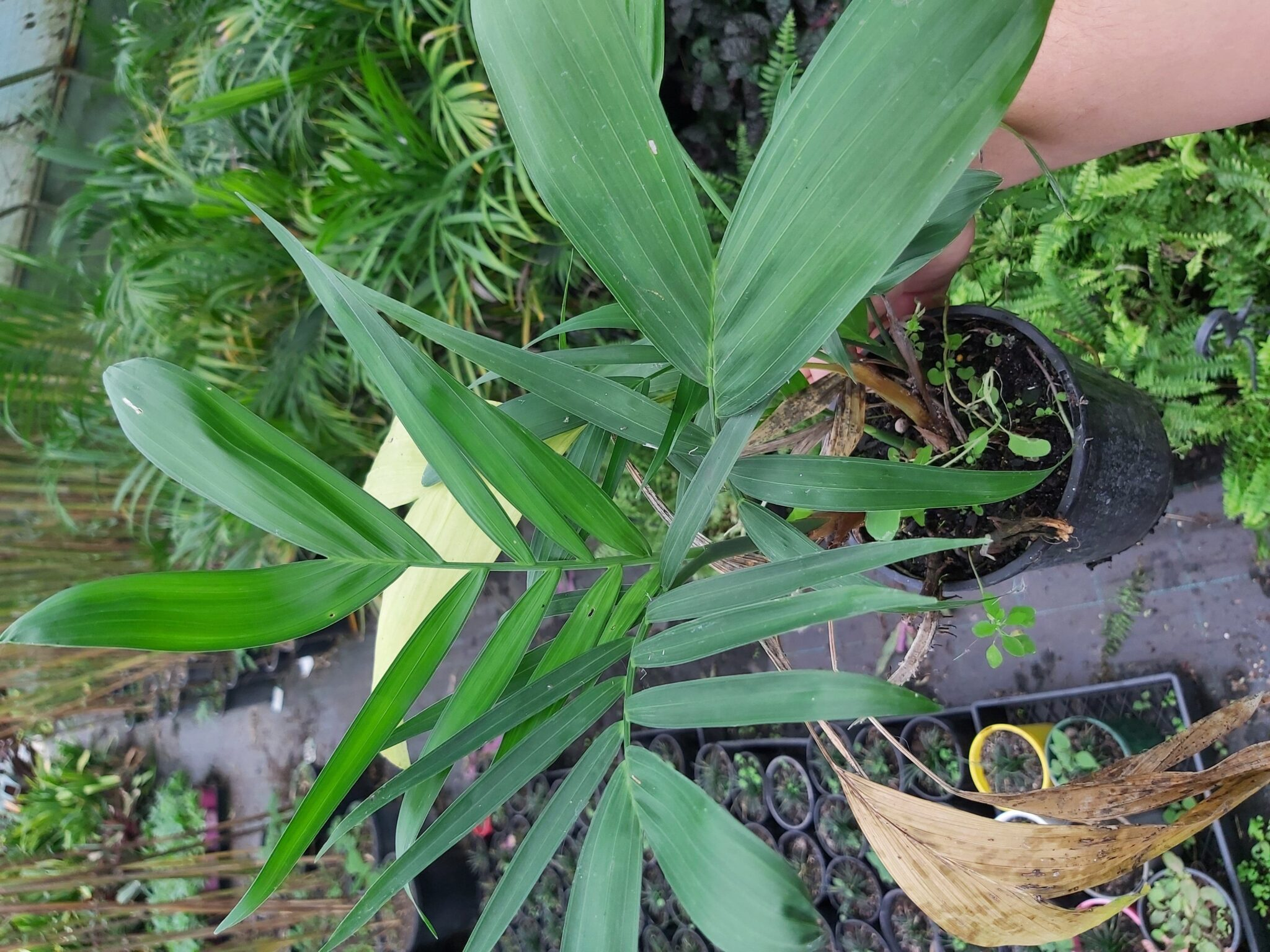HousePlantJoy is supported by our audience. When you purchase through one of our links, we may earn a small affiliate commission. As an Amazon Associate I earn from qualifying purchases. Your cost is not affected.
==================
As an avid indoor gardener passionate about creating lush green spaces within the confines of my home, I’ve discovered a true gem in houseplants: the Bamboo Palms. My experience with this delightful botanical companion has been incredibly rewarding, and I’m excited to share my knowledge and experiences with fellow enthusiasts. Nestled in the corner of my living room, my Bamboo Palm stands tall, its vibrant green fronds swaying gently in the breeze. When I welcomed this elegant plant into my home, I was captivated by its beauty and intrigued by its reputation for improving indoor air quality.
Over time, I’ve learned the ins and outs of caring for Bamboo Palms, from finding the perfect balance of light and water to understanding their preferences for humidity and soil conditions. Through trial and error, I’ve honed my skills as a caretaker, ensuring that my Bamboo Palm thrives year-round.
But beyond its aesthetic appeal, I’ve come to appreciate the myriad benefits that the Bamboo Palm brings to my home. Join me on this journey as we delve into the wonders of Bamboo Palms and uncover why they’re the perfect addition to your home.
Bamboo Palms: Bringing Nature’s Serenity Indoors
Photo by: Gardening Know How
Let’s talk about something that’s been a game-changer in my home: Bamboo Palms. These beauties aren’t just your average houseplants; they’re like little pieces of nature’s serenity in your living room. Since I brought them into my space, it’s been a whole new vibe – calm, fresh, and peaceful. Whether you’re a seasoned plant parent or just dipping your toes into indoor gardening, Bamboo plants are a fantastic choice. Stick around, and I’ll spill the beans on why Bamboo Palm Plant are the ultimate green companions for your indoor oasis.
Key Highlights:
- Bamboo palms, also known as Chamaedorea seifrizii, are popular houseplants originating from the lush rainforests of Central and South America.
- The Bamboo plant introduces a clean, elegant aesthetic, infusing a tropical ambiance into any indoor environment.
- From easy care to aesthetic appeal, Bamboo Palms are the perfect addition to your home greenery. Moreover, they are non-toxic to humans and animals, making them an ideal household choice.
- You can seamlessly incorporate Bamboo Palms into your landscaping or design.
- With proper care, your Bamboo Palm will thrive, bringing enduring elegance and tropical charm to your indoor space for years.
Bamboo Palm: Unveiling Its Roots and Appearance
Photo by: Bamboo Land
Bamboo palms, known by their botanical name Chamaedorea seifrizii, are popular as houseplants. They hail from the lush rainforests of Central and South America, particularly in places like Mexico and Central America. You’ll often spot them hanging out as understory plants, enjoying taller trees’ cozy shade. They’re perfectly suited for that laid-back rainforest vibe. Bamboo palms grow naturally in clumps, adding to their lush appearance and making them a great choice for indoor greenery. Whether you’re a seasoned plant parent or just starting, bamboo palm plants are a fantastic addition to any home.
Exploring Its Appearance
Let’s break down how the Bamboo Palm, a popular houseplant, looks:
- Fronds: Picture lush, green fronds that steal the show. They’re feathery and gracefully arch, giving off a soft, airy vibe.
- Stems: Now, these stems are something. They’re slender and stand tall, almost like bamboo stalks. You’ll usually see them in shades of green or brown, and they can stretch out to several feet.
- Growth Pattern: Think clusters. Bamboo Palms, a great choice among tropical plants, like to grow in clumps, with multiple stems popping up from one base. It’s what gives them that lush, bushy appearance.
- Size: They’re not too big, not too small—just right for indoor spaces. Usually, they stand around 3-6 feet tall, perfect for apartments or rooms where space is at a premium.
The Bamboo Palm, a popular houseplant among tropical plants, brings a clean, elegant look that adds a tropical touch to any indoor setting.
Chamaedorea Seifrizii: A Perfect Fit for Your Home Greenery
Photo by: MyDomaine
Bamboo Palms are just top-notch when it comes to houseplants, and here’s why:
Easy Care
They tolerate various light conditions, from bright indirect light to lower-light settings. So, whether your space gets loads of sunshine or prefers a dimmer vibe, these palms can handle it all.
Low Maintenance
Forget about constant watering and feeding schedules. Most Bamboo Palms are chill about that. And a little monthly feeding during the warmer months is all they need to stay happy.
Air Purifying
Talk about a bonus! Bamboo Palms not only look good but also do some serious work in cleaning up the air. They filter out nasties like formaldehyde and benzene, leaving your home fresher and healthier.
Relatively Small Size
Don’t stress about them taking over your space. These popular houseplants keep it manageable, perfect for cozy apartments or rooms with tight space.
Aesthetics
And let’s not forget the main attraction – their lush green leaves. They bring that touch of elegance and tropical vibes that can transform any room into a little paradise.
Here’s a video about other palms you might want to cultivate.
By: That’s Mary
Are Chamaedorea Seifrizii Toxic to Pets or Humans?
Photo by: The Jungle Collective
Bamboo Palms (Chamaedorea seifrizii) are usually seen as safe for humans, cats, and dogs, according to ASPCA. This means you can breathe easy, knowing they’re a good pick for homes with pets and kids.
Bringing Bamboo Palms into Your Landscape: Design Tips and Ideas
Photo by: Camden Nurseries
Bamboo Palms (Chamaedorea seifrizii) are usually the stars indoors, gracing our homes as lovely houseplants. But guess what? If you’re fortunate to reside in USDA Hardiness Zones 10 and 11, where the weather stays warm throughout the year, you can also show them some outdoor love! Here’s the scoop on incorporating Bamboo Palms into your landscaping or design:
Outdoors (Zones 10-11)
- Focal Point: Pop one of these babies in a container or a designated spot in your garden, and bam! Instant tropical vibes on your patio or in your yard.
- Privacy Screen: Do you need some privacy? Line the plants up with enough space between each one, and you’ve got yourself a living green wall—perfect for cozying up your space.
- Shade Provider: Stick them under taller trees where they can soak up filtered sunlight. They not only add some greenery but also offer some shade for your chill-out spots.
- Tropical Border: Pair them with other shade-loving pals like ferns, bromeliads, or flowering gingers for a lush, vibrant tropical border. Talk about making a statement!
Indoors
- Tabletop Greenery: Their compact size makes them perfect for jazzing up tables, desks, or shelves. Just a little touch of life wherever you need it.
- Hanging Basket: Some types have fronds that cascade down beautifully, making them ideal for hanging baskets. It’s like instant green curtains!
- Corner Accent: Brighten a well-lit corner in your living room or bedroom with these tropical beauties. They’ll turn any forgotten nook into a cozy oasis.
- Bathroom Thrive: Since they dig moderate Humidity, bathrooms with indirect sunlight are their jam. Talk about turning your bathroom into a spa-like retreat!
General Design Tips
- Container Selection: Pick a pot that matches the size and style of your Bamboo Palm. Oh, and make sure it has drainage holes—nobody likes soggy roots!
- Grouping: Wanna level up your game? Group different-height Bamboo Palms together for a fuller, more interesting look.
- Mixing and Matching: Get creative! Pair Bamboo Palms with other houseplants that have different foliage textures or colors. It’s all about that dynamic display.
Bamboo Palms are pretty chill. With a little TLC and the right spot, they’ll bring elegance and tropical vibes to your indoor or outdoor space, no sweat. Watch out for too much bright or direct sunlight, as it can cause leaf burn. Oh, and be mindful when planted outdoors to ensure they get along with other plants in your garden.
Bamboo Palm Care: Tips for Thriving Indoor Greenery
Photo by: The Palm Centre
Alright, let’s talk Bamboo Palm (Chamaedorea seifrizii)! This plant is a real gem for houseplants, and taking care of it is a breeze. Here’s the lowdown on keeping your Bamboo Palm happy and thriving indoors:
Light
- Bright Indirect Light: These guys love bright, indirect light. Keep them away from harsh direct sunlight, which is too much for their delicate fronds.
- Adaptable: They’re pretty chill and can handle lower light conditions, too, but know that their growth might slow down a tad.
- Avoid Sudden Changes: If you need to move your plant around, do it gradually. Let it ease into its new spot to avoid any light-related shock.
Water
- Water When Dry: Give your Bamboo Palm a drink once the top inch of soil is completely dry. Overwatering is a big no-no for these guys.
- Consistent Moisture: Make the soil evenly moist, but don’t drown it. Good drainage is key here, so ensure your pot has those drainage holes.
Humidity
- High Humidity Preferred: These palms dig moderate to high humidity levels, so if your place is on the dry side, consider misting the leaves or using a pebble tray to amp up the moisture.
Temperature
- Warm Temperatures: They thrive in warmer temps, ideally between 65-80 degrees Fahrenheit (18-27 degrees Celsius).
- Avoid Cold Drafts: Keep them away from chilly drafts or sudden temperature swings; they’re not big fans.
Soil and Fertilizer
- Well-Draining Mix: Use a potting mix that drains well and is rich in organic matter. Think potting soil mixed with perlite and peat moss for a winning combo.
Fertilize During Growth Season
- During the growing season, feed your Bamboo Palm with a balanced liquid fertilizer.
Other Care Tips
- Repotting: Give your plant a new home every 2-3 years or when the roots start getting cramped. Choose a pot that’s a smidge bigger than the old one.
- Cleaning: Dust off those leaves now and then with a damp cloth to keep them shiny and happy.
- Pests and Diseases: Pests and Diseases: These guys are usually tough but watch for sneaky bugs like spider mites and diseases.
Follow these simple guidelines, and your Bamboo Palm will live its best life, bringing a touch of elegance and the tropics to your indoor space for years to come.
Here’s a video about Chamaedorea seifrizii that covers its care and maintenance.
By: WhatsThatPlant
Bamboo Palms: Your Pathway to Indoor Greenery Bliss
Bamboo Palms are the perfect green companions for any home, offering aesthetic beauty and many benefits. As an indoor gardener, I’ve found Bamboo Palms to be a true gem, enhancing the ambiance of my living space and improving indoor air quality. Their graceful appearance and ease of care make them ideal choices for both seasoned plant enthusiasts and beginners.
From understanding their origins and appearance to exploring various design possibilities for both indoor and outdoor spaces, Bamboo Palms offer endless opportunities to elevate your home décor and create a tranquil oasis. With proper care, these versatile plants thrive effortlessly, adding a touch of elegance and the tropics to any setting.
Whether adorning a tabletop, hanging gracefully in a basket, or providing a lush backdrop to your outdoor landscape, Bamboo Palms bring nature’s serenity indoors and outdoors. Their resilience, air-purifying qualities, and low-maintenance nature make them indispensable to any home. So, join me in embracing the wonders of Bamboo Palms and discover why they’re the perfect green companions for your home.
If you’re ready to bring the beauty and serenity of Bamboo Palms into your home, visit House Plant Joy’s website today to explore a wide selection of these wonderful plants and start your journey to indoor greenery bliss!
FAQs
Does the Bamboo Palm Have Flowers?
Bamboo Palms (Chamaedorea seifrizii) generally do not produce flowers when grown indoors. Instead, they are admired for their lush green foliage.
Should I Prune My Bamboo Palm?
No need to stress over-pruning your Bamboo Palm! Here’s the easy version:
- It naturally grows slowly and maintains a bushy appearance.
- Trim off any brown or dead leaves using sharp scissors.
- Avoid cutting the top or attempting to shorten it.
Is the Bamboo Palm Related to Bamboo?
Bamboo Palms and bamboo might share some visual similarities, like their long, green leaves and slender stalks, but they’re actually from different plant families.
Bamboo Palms belong to the palm family, while bamboo is part of the Poaceae family. So, despite the name, they’re not directly related.
Welcome to Houseplant Joy: Your Green Haven!
Hey there, fellow plant lover! Ready to dive into the wonderful world of houseplants with us?
Whether you’re a seasoned plant parent or just starting your green journey, Houseplant Joy is your go-to destination for all things leafy and lovely!
Check out our vibrant community across different social media platforms:
| Platform | Link |
|---|---|
| Join us on Facebook | |
| Follow us on Instagram | |
| Pin with us on Pinterest | |
| Tweet with us on Twitter | |
| YouTube | Subscribe to us on YouTube |
| TikTok | Dance with us on TikTok |
- Connect with fellow plant enthusiasts, get daily tips, and share your green space photos on Facebook!
- Explore stunning plant photography, behind-the-scenes peeks, and community highlights on Instagram!
- Discover curated boards filled with plant inspiration, DIY projects, and more on Pinterest!
- Join the conversation, stay updated on the latest trends, and connect with like-minded plant lovers on Twitter!
- Dive deep into plant care guides, product reviews, and engaging content on our YouTube channel!
- Get ready to groove to plant-themed tunes, quick tips, and fun content on TikTok!
Ready to join our green-loving community? Let’s grow together at Houseplant Joy!















